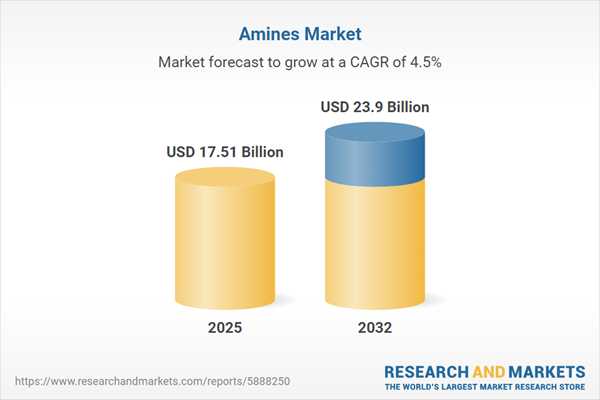Speak directly to the analyst to clarify any post sales queries you may have.
The global amines market is experiencing rapid evolution as organizations sharpen strategies to meet sustainability targets and stay ahead of regulatory and technological trends. Senior leaders are focused on enhancing compliance, operational efficiency, and supply resilience in a market marked by ongoing change.
Market Snapshot: Global Amines Market Size, Growth, and Outlook
The global amines market is projected to reach USD 23.90 billion by 2032, rising from USD 16.77 billion in 2024, with a compound annual growth rate (CAGR) of 4.53%. Expansion is driven by digital technology adoption, which streamlines manufacturing and optimizes procurement and supply chain operations. As industry participants align sourcing and workflows with updated regulatory standards, amines are finding broader applications across an expanding portfolio of industrial sectors. These developments highlight growing industry demand for compliance solutions and innovation in response to evolving operational requirements.
Amines Market Scope & Segmentation
- Product Types: Diethanolamine, ethylenediamine, monoethanolamine, and triethanolamine each bring unique chemical reactivity and safety profiles to manufacturing processes. These product types enable precise customization in industrial applications, supporting advanced formulations and addressing the specific needs of various sectors.
- Applications: Amines are key in agrochemicals, pharmaceuticals, gas treatment, surfactants, and water treatment, contributing to higher yields, improved purification processes, and operational stability. Their use supports both infrastructure maintenance and product performance in commercial and industrial contexts.
- End Use Industries: Core sectors such as agriculture, oil and gas, personal care, and pharmaceuticals rely on amines for quality assurance and compliance with strict operational and environmental standards. These industries leverage amine-based solutions to enhance performance and meet the demands of global regulatory frameworks.
- Regional Coverage: The Americas, Europe, Middle East, Africa, and Asia-Pacific each present unique operating landscapes, shaped by variations in local compliance rules, technological integration, and sectoral growth rates. Regional strategy requires understanding technology uptake and adapting to differing regulatory environments across the global value chain.
- Leading Companies: BASF SE, The Dow Chemical Company, Huntsman Corporation, Eastman Chemical Company, Solvay SA, Clariant AG, Evonik Industries AG, Akzo Nobel N.V., Nippon Shokubai Co., Ltd., and Tosoh Corporation drive operational standards and influence innovation, establishing benchmarks that shape industry practices worldwide.
Key Takeaways for Senior Decision-Makers
- Advanced processing technologies reinforce compliance protocols, enabling organizations to maintain operational integrity while adapting to new regulatory landscapes.
- Integration of digital solutions—including predictive analytics and real-time supply chain monitoring—delivers greater visibility and supports proactive risk management across global operations.
- Renewable and bio-based input adoption strengthens sustainability initiatives and underpins robust supply networks, supporting organizations as they meet changing customer and legislative expectations.
- Effective collaboration with suppliers and clients allows for the delivery of tailored amine-based solutions, meeting specific operational and regulatory needs across diverse applications.
- Frequent portfolio reviews and agile decision-making provide the flexibility needed to swiftly navigate market volatility and regulatory adjustments.
- Partnering with technology providers and logistics specialists enhances end-to-end visibility and ensures continuity of supply, especially in dynamic or uncertain market conditions.
Tariff Impact: Navigating Market Disruptions
The upcoming 2025 tariff initiative in the United States amines market is prompting organizations to reconfigure sourcing models and adapt supplier networks. Domestic producers are retooling operations to meet new regulatory criteria, while importers are adjusting logistics and exploring alternate supply channels. These shifts are central to maintaining uninterrupted operations and ensuring compliance as the regulatory environment transforms.
Methodology & Data Sources
This analysis synthesizes feedback from executive and technical stakeholders with methodical reviews of major industry publications and comprehensive regulatory data. Every insight is rigorously validated to provide a reliable foundation for decision-making at senior levels.
Why This Report Matters
- Guides organizations through evolving regulatory environments with focus on compliance and efficient industrial operations.
- Supplies actionable intelligence on leveraging digital innovation and risk mitigation to enable adaptable, resilient supply chains.
- Clarifies how to align sustainability and operational objectives, delivering measurable value and market preparedness as industry dynamics shift.
Conclusion
Companies that emphasize sustainability, digital integration, and agile supply chain models are positioned to thrive as the global amines market changes. Continued innovation and flexible management will be central to ongoing competitiveness and resilience.
Additional Product Information:
- Purchase of this report includes 1 year online access with quarterly updates.
- This report can be updated on request. Please contact our Customer Experience team using the Ask a Question widget on our website.
Table of Contents
3. Executive Summary
4. Market Overview
7. Cumulative Impact of Artificial Intelligence 2025
Companies Mentioned
The companies profiled in this Amines market report include:- BASF SE
- The Dow Chemical Company
- Huntsman Corporation
- Eastman Chemical Company
- Solvay SA
- Clariant AG
- Evonik Industries AG
- Akzo Nobel N.V.
- Nippon Shokubai Co., Ltd.
- Tosoh Corporation
Table Information
| Report Attribute | Details |
|---|---|
| No. of Pages | 181 |
| Published | November 2025 |
| Forecast Period | 2025 - 2032 |
| Estimated Market Value ( USD | $ 17.51 Billion |
| Forecasted Market Value ( USD | $ 23.9 Billion |
| Compound Annual Growth Rate | 4.5% |
| Regions Covered | Global |
| No. of Companies Mentioned | 11 |









